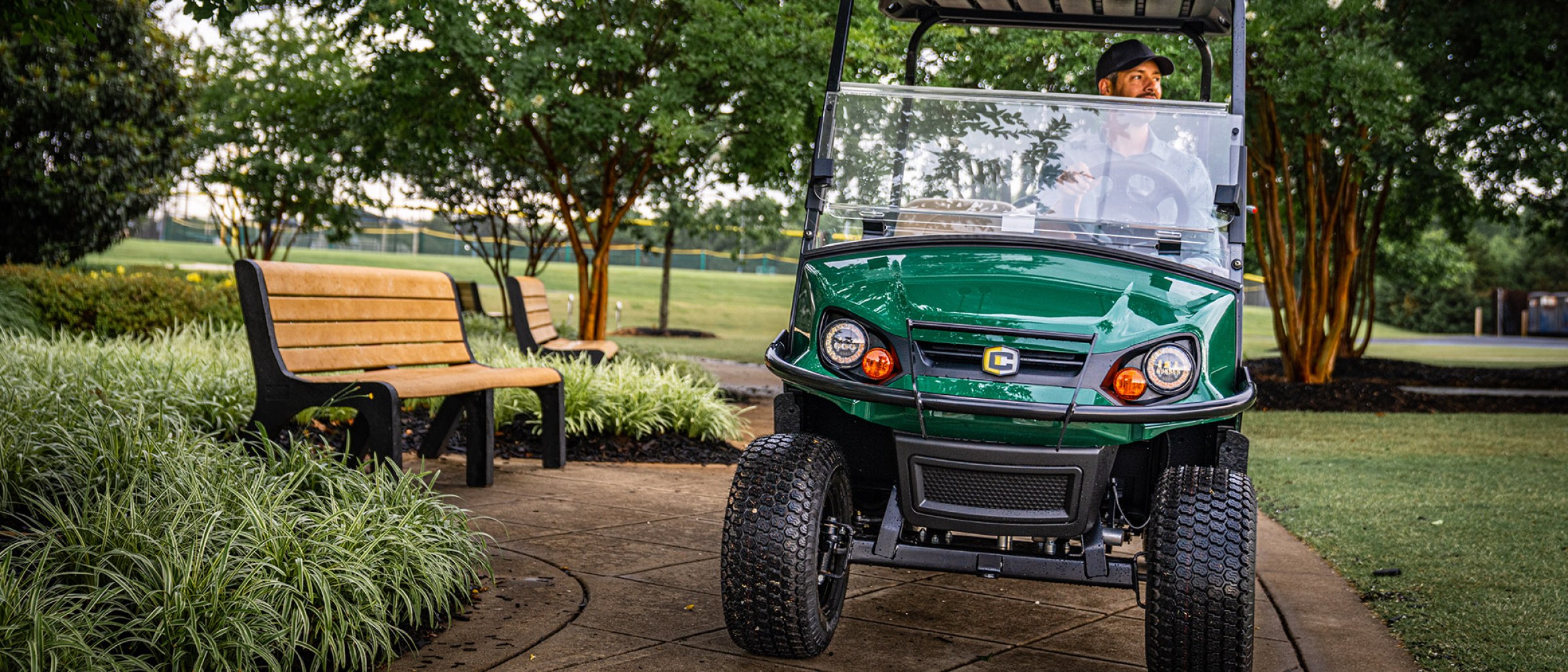Safety Information

Cushman® takes pride in a long history of building safe and reliable work vehicles to help you get the job done. The following tips and recommendations will help you ensure that both drivers and passengers end every work day without injury.
- Read and follow all safety precautions outlined in the owner’s manual of your Cushman vehicle. Also, know and follow all state and local regulations governing the use of light-transportation and utility vehicles in your area.
- Keep hands and feet inside the vehicle at all times.
- Do not operate the vehicle on public roads, unless such usage is allowed by state and local ordinances and the vehicle is equipped with all safety features and equipment required in your area.
- Never operate a Cushman vehicle under the influence of alcohol or any other substance.
- In vehicles equipped with bench seating, do not operate the vehicle with more than two (2) passengers per bench seat.
- Special care must be taken when using the vehicle in the presence of children. Do not allow young children or teenagers to operate the vehicle, particularly unattended. Cushman recommends that only licensed drivers operate Cushman vehicles.
- Do not allow young children to ride in the vehicle without a supervising adult. Children's feet must be able to touch the floorboard of the vehicle with their back firmly against the seatback, and they must be able to hold on to the safety handles on the vehicle canopy or restraint.
- Under no circumstances should a child-safety seat or booster seat be used in a Cushman vehicle. These seats were not designed for use in Cushman vehicles and cannot be properly secured to guard against injury.
- Make sure that tires are properly inflated before operating. Never install unapproved tires, including so-called “low-pressure” tires, on a personal-utility vehicle. The use of these tires can create an extremely unstable and hazardous operating condition.
- Modifications to the vehicle, such as the installation of a “lift kit” or rear-facing seat, can change the operating characteristics of the vehicle. Always be sure you understand and are mindful of the ways in which a modification can alter a vehicle’s behavior. Also, if modifying a vehicle, we recommend the use of Cushman Genuine Parts and Accessories, which have been tested to conform to safe operating standards and conditions. Cushman Genuine Parts and Accessories are available at your local Cushman dealer.
- Do not modify your Cushman vehicle to go faster than the speed at which it was designed to operate from the factory. Such modifications cause the vehicle to operate at a speed and in a manner for which it was not intended, designed, or tested. Such modifications also are often in violation of federal, state, and local laws governing the use of light transportation and utility vehicles.
- Passengers in a rear-facing seat must use particular care since they cannot see the upcoming path of the vehicle or possible approaching hazards. Rear-facing passengers must always hold on to safety handles and keep their feet firmly placed upon the vehicle’s floorboard.
Safety Information for Industrial Vehicles
- When vehicle is to be left unattended, turn key to OFF position AND REMOVE KEY.
- Avoid driving fast downhill. Sudden stops or change of direction may result in a loss of control. Use brake to control speed when traveling down an incline.
- Use extra care and reduced speed when driving in poor conditions or on poor surfaces.
- Stay in designated areas where provided and avoid steep slopes.
- Keep feet, legs, hands, and arms inside vehicle at all times.
- Avoid extremely rough terrain.
- Check area behind the vehicle before operating in reverse.
- Make sure the direction selector is in correct position before depressing the accelerator pedal.
- Slow down before and during turns.
- Always bring vehicle to a complete stop before shifting the direction selector.
- Before working on the vehicle, remove all jewelry.
- Be sure no loose clothing or hair can contact moving parts.
- Use care not to touch hot objects.
- Wear eye protection when working on or around the vehicle. In particular, use care when working around batteries, using solvents, or compressed air.
- Hydrogen gas is formed when charging batteries. Do not charge batteries without adequate ventilation.
- Do not permit open flame or anyone to smoke in an area that is being used for charging batteries.
- Do not charge the vehicle batteries in a hazardous location or atmosphere. Refer to NFPA505 for definitions of hazardous and non-hazardous locations.
See Owner’s Manual for vehicle load and seating capacity and additional safety information. This is not an exhaustive list of safety guidelines and precautions. No list, however lengthy, could ever cover all possible operating situations and conditions for every Cushman vehicle in every possible environment. If you have any questions about the safe and proper use of your Cushman vehicle, please contact Cushman at 1(800) 241-5855.
Again, no safety feature or guideline will replace the old-fashioned common sense of responsible drivers and passengers. Please operate your Cushman vehicle responsibly and thank you for supporting Cushman.